Category: International EM
Keywords: Bioterrorism, anthrax, botulism, plague, smallpox, tularemia, viral hemmorrhagic fevers (PubMed Search)
Posted: 11/5/2014 by Jon Mark Hirshon, MPH, MD, PhD
Click here to contact Jon Mark Hirshon, MPH, MD, PhD
Background: The Centers for Disease Control and Prevention (CDC) classifies potential bioterrorism agents into three categories, with Category A the most deadly.
Category A: These are the highest priority agents/diseases because they:
Specific Category A Agents/Diseases:
Bottom Line: With the exception of smallpox, these disease still occur in various parts of the globe including the United States. As can be seen by the current Ebola epidemic in West Africa, the U.S. public health system and healthcare providers must be prepared to recognize and treat these agents.
Reference: http://www.bt.cdc.gov/agent/agentlist-category.asp
Category: Visual Diagnosis
Posted: 11/4/2014 by Haney Mallemat, MD
(Updated: 11/5/2014)
Click here to contact Haney Mallemat, MD
A patient presents post-motor vehicle crash with chest pain and dyspnea. The lung ultrasound is shown below. What's the diagnosis?
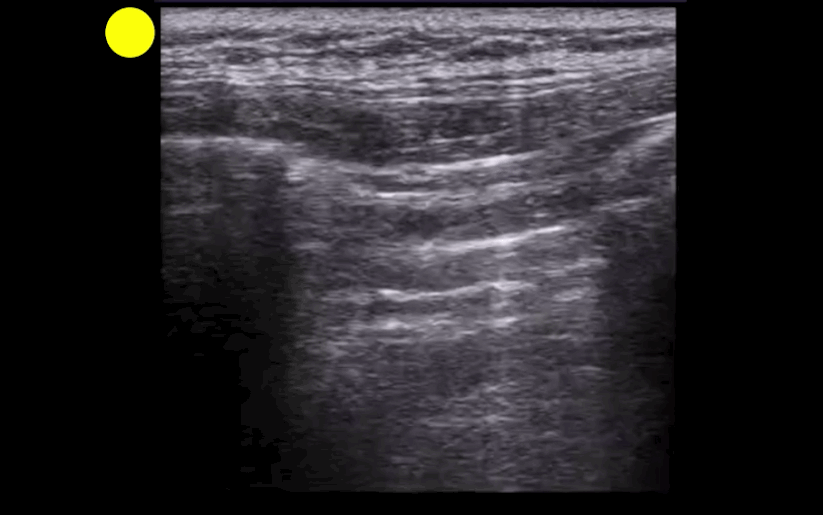
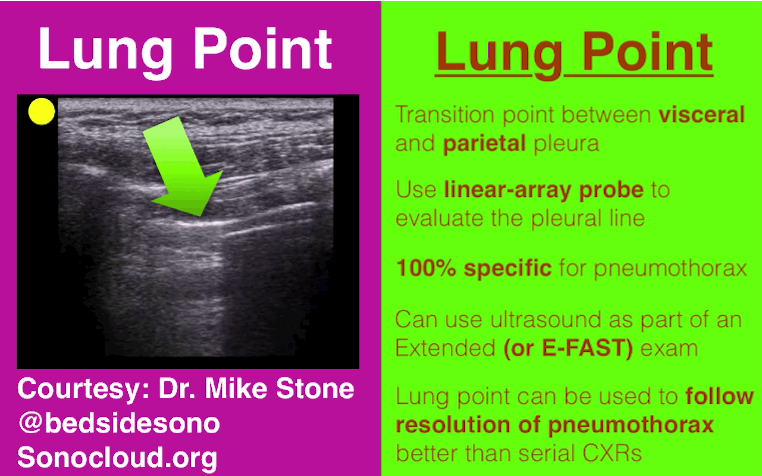
Follow me on Twitter (@criticalcarenow) or Google+ (+criticalcarenow)
Category: Critical Care
Keywords: Airway, critical care, RSI, rapid sequence intubation (PubMed Search)
Posted: 11/3/2014 by John Greenwood, MD
(Updated: 11/4/2014)
Click here to contact John Greenwood, MD
Back 2 Basics Series: Your Simple RSI Checklist - SOAP ME
The use of a checklist during high stress medical procedures is often recommended. Rapid sequence intubation (RSI) is a classic situation where having a checklist can ensure adequate preparation however, if you don’t have a checklist – this simple mnemonic will make sure you are well prepared for a successful intubation.
| Mnemonic – “SOAP ME” | |
|---|---|
| Suction |
|
| Oxygen |
|
| Airways |
|
| Positioning |
|
| Monitors & Meds |
|
| EtCO2 & other Equipment |
|
The SOAP ME mnemonic is a quick and useful technique to remember only the basics of airway management and preparation. Always remember to also assign roles to team members and communicate clearly to maximize your chances of success.
Category: Cardiology
Posted: 11/2/2014 by Semhar Tewelde, MD
Click here to contact Semhar Tewelde, MD
Heart Failure & Pulmonary Hypertension (Part II)
- HFpEF-PH management guidelines recommend the treatment of symptoms of congestion and volume overload, targeting LV relaxation and co-morbidities; including the management of pulmonary congestion, ischemia, sleep apnea, atrial fibrillation, and diabetes.
- Both atrial/ventricular dysrhythmias contribute to the mortality associated with HF & control of particularly atrial fibrillation, is an essential part of the early pulmonary vascular remodeling process.
- Both endothelin receptor antagonists (ERA) and prostanoids have been effective for PAH & clinical trials utilizing these agents have also been attempted in treatment of PH due to left heart disease, but have proven to be either neutral or even detrimental.
- Selective dilation of the pulmonary vessels in patients with postcapillary PH, without simultaneously ensuring the unloading of the LV, can cause profound pulmonary venous congestion resulting in sudden pulmonary edema, which greatly increases the morbidity in patients with this form of PH.
- Currently, the most compelling published data for pharmacological treatment targeting PH in HFpEF involves phosphodiesterase (PDE) inhibitor sildenafil.
Kanwar M, Tedford R, et al. Management of Pulmonary Hypertension due to Heart Failure with Preserved Ejection Fraction. Current Hypertension Reports. October 16, 2014.
Category: Pharmacology & Therapeutics
Keywords: penicillin, cephalosporin, allergy, cross-reactivity (PubMed Search)
Posted: 10/7/2014 by Bryan Hayes, PharmD
(Updated: 11/4/2014)
Click here to contact Bryan Hayes, PharmD
The cross-reactivity between cephalosporins and penicillins is significantly lower than the 10% figure many of us learned. In fact, the beta-lactam ring is rarely involved. So, when the warning pops up next time you order ceftriaxone in a penicillin-allergic patient, what should you do?
In a patient with a documented penicillin allergy, here is a simple chart to help determine when a cephalosporin is ok to use:
Common penicillins and cephalosporins with similar side chains include ampicillin/amoxicillin and cephalexin, cefaclor, cephadroxil, and cefprozil.
Campagna JD, et al. The use of cephalosporins in penicillin-allergic patients: a literature review. J Emerg Med 2012;42(5):612-20. [PMID 21742459]
Pichichero ME, et al. Penicillin and cephalosporin allergy. Ann Allergy Asthma Immunol 2014;112:404-12. [PMID 24767695]
Follow me on Twitter (@PharmERToxGuy) or Google Plus (+bryanhayes13)
Category: International EM
Keywords: Ebola, CDC, Isolation (PubMed Search)
Posted: 10/28/2014 by Jon Mark Hirshon, MPH, MD, PhD
(Updated: 10/29/2014)
Click here to contact Jon Mark Hirshon, MPH, MD, PhD
Background:
ED Algorithm For Patients with Possible Ebola
If yes to both identification questions, then:
Bottom line:
Whether the patient has Ebola or not, a well-developed response is necessary for patient management and public health preparedness. The fear of the disease is much more widespread and impactful than the disease itself.
See the full algorithm, with more details at: http://www.cdc.gov/vhf/ebola/pdf/ed-algorithm-management-patients-possible-ebola.pdf
Category: Cardiology
Posted: 10/26/2014 by Semhar Tewelde, MD
(Updated: 12/17/2025)
Click here to contact Semhar Tewelde, MD
Heart Failure & Pulmonary Hypertension (Part I)
~50% of patients with heart failure & preserved ejection fraction (HFpEF) develop pulmonary hypertension (PH)
HFpEF with PH portends reduced survival and increased hospitalization rates compared to those without PH
HFpEF-PH is often confused with idiopathic pulmonary hypertension (IPAH) given the similar hemodynamics; differentiating them is challenging and requires careful consideration of clinical, radiologic, and hemodynamic data
|
| PAH | HFpEF |
| Clinical parameters: | ||
| Age | Typically 3rd–5th decade | Typically 6th–8th decade |
| Comorbidities (HTN, HLD, DM, CAD) | Rare | Common |
| Atrial arrhythmias | Rare | Common |
| Obstructive sleep apnea | Rare | Common |
| Echocardiographic parameters: | ||
| LA size/volume | Normal | Increased |
| LV diastolic function | Normal to mildly abnormal | Moderate to severely abnormal |
| Hemodynamic parameters: | ||
| Resting PAWP | Always <15 mmHg | May be < or >15 mmHg |
| Response to volume | PAWP <15 mmHg (increase ≤5 mmHg) | PAWP >15 mmHg (increase >5 mmHg) |
| Response to exercise | PAWP <15 mmHg (increase ≤5 mmHg) | PAWP >15 mmHg (increase >5 mmHg) |
(Table reproduced from article)
Kanwar M, Tedford R, et al. Management of Pulmonary Hypertension due to Heart Failure with Preserved Ejection Fraction. Current Hypertension Reports. October 16, 2014
Category: Orthopedics
Keywords: Osteoporosis, elderly, (PubMed Search)
Posted: 10/25/2014 by Brian Corwell, MD
Click here to contact Brian Corwell, MD
Iliocostal syndrome aka iliocostal friction syndrome
Consider this entity in an elderly patient with osteoporosis with unexplained abdomen/flank or back pain.
Osteoporosis and/or vertebral compression fractures can result in a narrowing of the distance between .
the lowest anterior rib and the top of the iliac crest producing pain where this rib contacts the pelvis.
This can be perceived as side or back pain. This pain can restrict walking leading to a possible misdiagnosis of spinal stenosis. Treatment is with physical therapy and therapeutic injection.
http://www.caringmedical.com/wp-content/uploads/2013/09/iliocostalis.syndrome.jpg
Category: Toxicology
Keywords: tetracycline (PubMed Search)
Posted: 10/23/2014 by Fermin Barrueto
(Updated: 12/17/2025)
Click here to contact Fermin Barrueto
Category: Neurology
Keywords: neurosurgery, trauma (PubMed Search)
Posted: 10/23/2014 by Danya Khoujah, MBBS
Click here to contact Danya Khoujah, MBBS
The 2013 neurosurgery guidelines mention two of the more controversial therapies used in spinal cord injuries:
- “MAP Push” (maintaining the patient’s MAP 85-90mmHg, which theoretically increases the blood flow to the penumbra): evidence for the particular MAP goal is not great, but studies show that ICU level monitoring for the first 7-14 days improves outcome as patients may have delayed cardiovascular or pulmonary instability
- Steroids are not recommended anymore (they were an “option” in the previous guidelines)
Neurosurgery. 2013 Mar;72. Updated Guidelines for the Management of Acute Cervical Spine and Spinal Cord Injury. Resnick DK
Category: Critical Care
Keywords: choosing wisely, icu, critical care (PubMed Search)
Posted: 10/21/2014 by Feras Khan, MD
(Updated: 12/17/2025)
Click here to contact Feras Khan, MD
Choosing Wisely in the ICU
The Critical Care Societies Collaborative came up with this list for ICU providers
1. Don’t order diagnostic tests at regular intervals (such as every day) but rather in response to specific clinical questions. Do you really need a daily INR check or CBC check in all ICU patients? Really?
2. Don’t transfuse red blood cells in hemodynamically stable, non-bleeding ICU patients with a hemoglobin concentration greater than 7 g/dl. See last week’s Pearl!
3. Don’t use parental nutrition in adequately nourished critically ill patients within the first seven days of an ICU stay. TPN is the Cinnamon Toast Crunch of fungi.
4. Don’t deeply sedate mechanically ventilated patients without a specific indication and without daily attempts to lighten sedation. Use as little as possible when you can.
5. Don’t continue life support for patients at high risk for death or severely impaired functional recovery without offering patients and their families the alternative of care focused entirely on comfort. Engage families early in the hospital stay regarding aggressive life-sustaining treatments. Get palliative care involved in the ED!
Crit Care Med. 2014 Nov;42(11):2437-8. doi: 10.1097/CCM.0000000000000696.
Angus DC1, Deutschman CS, Hall JB, Wilson KC, Munro CL, Hill NS.
Category: Visual Diagnosis
Posted: 10/20/2014 by Haney Mallemat, MD
(Updated: 11/4/2014)
Click here to contact Haney Mallemat, MD
13 year-old right-hand dominant following assault with blunt object. What’s the diagnosis?
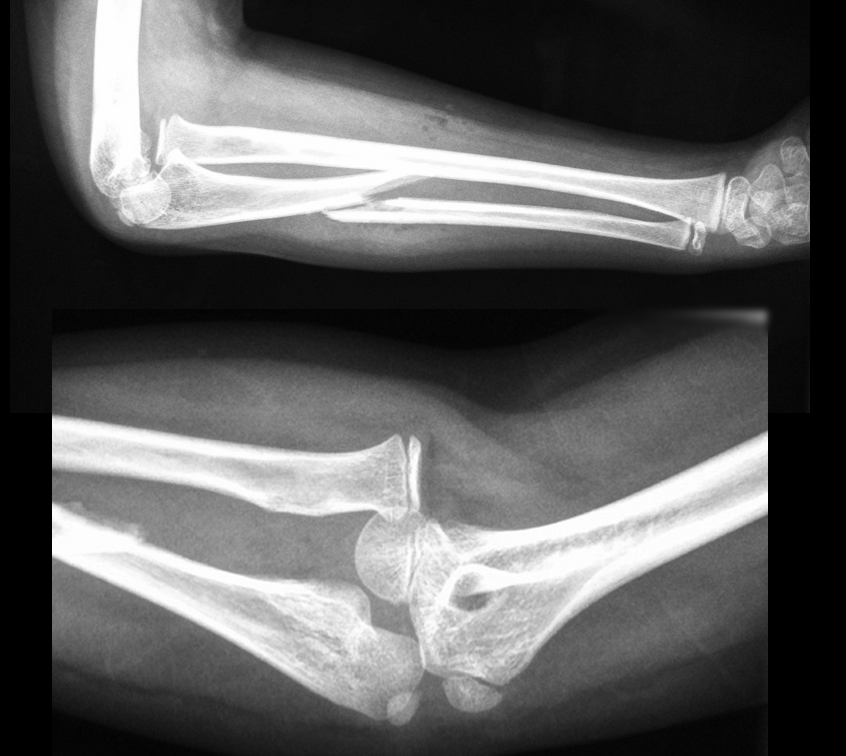
Monteggia Fracture
Follow me on Twitter (@criticalcarenow) or Google+ (+criticalcarenow)
Category: Cardiology
Posted: 10/19/2014 by Semhar Tewelde, MD
Click here to contact Semhar Tewelde, MD
Cardiovascular Morbidity & Sleep Apnea
Obstructive sleep apnea (OSA) is characterized by sleep-related periodic breathing, upper-airway obstruction, sleep disruption, and hemodynamic perturbations
Epidemiological data shows a strong association between untreated OSA & cardiovascular morbidity/mortality
Two recent studies by Gottlieb et al. (1) & Chirinos et al. (2) elucidated two important explicit and complicit treatment considerations for OSA
(1) In moderate-to-severe obstructive sleep apnea, the use of CPAP alone during sleep may ameliorate systemic hypertension and cardiovascular risk, even in patients who do not have "subjective" sleepiness
(2) Weight loss combined with CPAP use may further decrease cardiovascular morbidity
Basner R. Cardiovascular Morbidity and Obstructive Sleep Apnea. N Engl J Med 2014; 370:2339-2341 June 12, 2014
Category: Orthopedics
Keywords: Segond, Reverse, Fracture (PubMed Search)
Posted: 10/19/2014 by Michael Bond, MD
Click here to contact Michael Bond, MD
The Reverse Segond Fracture
Most people have heard of a segond fracture (avulsion fracture of the lateral tibeal platuea) seen on knee xrays which is a marker for Anterior Cruciate Ligament and medial meniscus injuries. See Pearl https://umem.org/educational_pearls/1015/
However, there is also a Reverse Segond Fracture that is another benign appearing avulsion fracture of the medial tibeal plateau that is marker for significant injury to the Posterior Cruciate Ligament (PCL).
If a Segond or Reverse Segond Fracture is seen consider immobilzing the patients knee until they can follow up with Orthopedics and/or get an MRI to determine if additional injuries are present.
Category: Pediatrics
Keywords: Lactate (PubMed Search)
Posted: 10/17/2014 by Jenny Guyther, MD
(Updated: 12/17/2025)
Click here to contact Jenny Guyther, MD
The world of pediatrics is still working on catching up to adult literature in terms of lactate utilization and its implications. The study referenced looked at over 1000 children admitted to the pediatric intensive care unit. Lactate levels were collected 2 hours after admission and a mortality risk assessment was calculated within 24 hours of admission (PRISM III). Results showed that the lactate level on admission was significantly associated with mortality after adjustment for age, gender and PRISM III score.
Bottom line: In your critically ill pediatric patient, lactate may be a useful predictor of mortality.
Bai Z et al. Effectiveness of predicting in-hospital mortality in critically ill children by assessing blood lactate levels at admission. BMC Pediatrcs 2014; 14:83.
Category: International EM
Keywords: Infectious diseases, isolation, quarantine (PubMed Search)
Posted: 10/16/2014 by Jon Mark Hirshon, MPH, MD, PhD
Click here to contact Jon Mark Hirshon, MPH, MD, PhD
With all the current concern about Ebola, it is important to understand what are quarantine and isolation and who can order these.
Per the Centers for Disease Control:
Federal Law allows for quarantine and isolation:
State laws allows for the enforcement of isolation and quarantine within their borders.
Bottom Line:
Category: Toxicology
Keywords: valproic acid (PubMed Search)
Posted: 10/16/2014 by Hong Kim, MD
(Updated: 12/17/2025)
Click here to contact Hong Kim, MD
Valproic acid (VPA) is often used to treat seizure disorder and mania as a mood stabilizer. The mechanism of action involves enhancing GABA effect by preventing its degradation and slows the recovery from inactivation of neuronal Na+ channels (blockade effect).
VPA normally undergoes beta-oxidation (same as fatty acid metabolism) in the liver mitochondria, where VPA is transported into the mitochondria by carnitine shuttle pathway.
In setting of an overdose, carnitine is depleted and VPA undergoes omega-oxidation in the cytosol, resulting in a toxic metabolite.
Elevation NH3 occurs as the toxic metabolite inhibits the carbomyl phosphate synthase I, preventing the incorporation of NH3 into the urea cycle.
Signs and symptoms of acute toxicity include:
Laboratory abnormalities
Treatment: L-carnitine
Goldfrank's Toxicologic Emergencies 9th ed. P 705
Category: Critical Care
Posted: 10/14/2014 by Mike Winters, MBA, MD
(Updated: 12/17/2025)
Click here to contact Mike Winters, MBA, MD
Hemoglobin Threshold in Septic Shock
Holst LB, et al. Lower versus higher hemoglobin threshold for transfusion in septic shock. NEJM 2014; [published online]
Category: Visual Diagnosis
Posted: 10/13/2014 by Haney Mallemat, MD
Click here to contact Haney Mallemat, MD
A neck ultrasound is performed during endotracheal intubation. What is labeled "A", what is labeled "B" and what's the diagnosis?
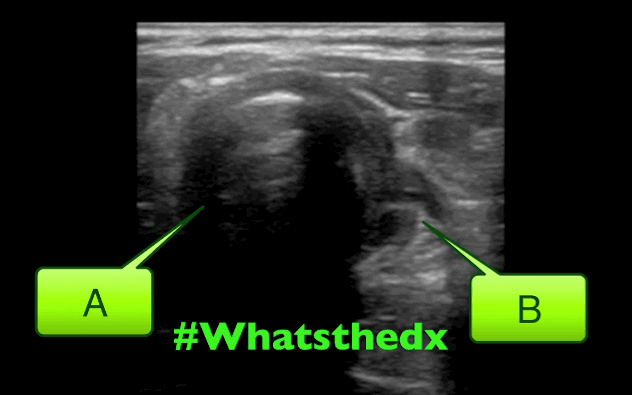
Answer:
A: Trachea
B: Esophagus
This is an esophageal intubation! Take out the tube and try again. Check out this podcast for more on the technique from my good friends at the ultrasound podcast
Here's a summary:
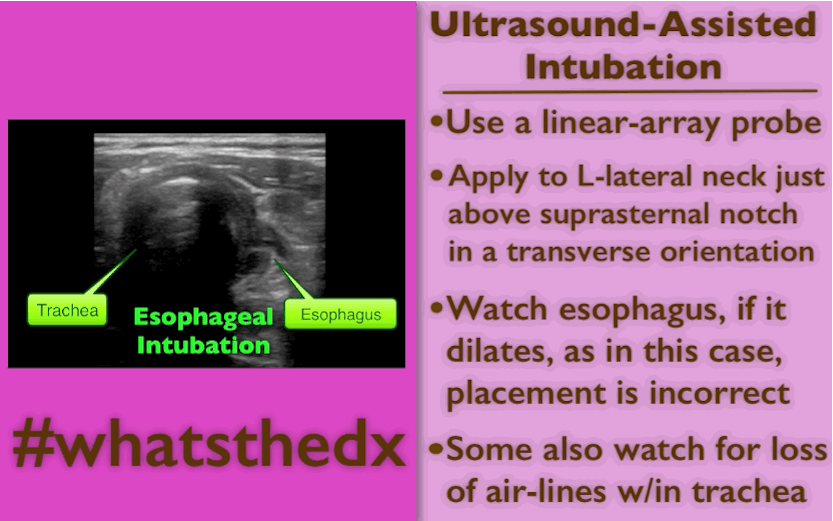
Follow me on Twitter (@criticalcarenow) or Google+ (+criticalcarenow)
Category: Cardiology
Posted: 10/12/2014 by Semhar Tewelde, MD
(Updated: 12/17/2025)
Click here to contact Semhar Tewelde, MD
Kounis Syndrome (Part II)
- KS can develop from multiple etiologies: hymenoptera, proteins, vasoactive amines, histamine, acetylcholine, multiple antibiotics, and various medical conditions (angioedema, serum sickness, asthma, stress-induced cardiomyopathy).
- Hypersensitivity myocarditis and KS are two cardiac entities of allergic etiology affecting the myocardium and coronary arteries, respectively. These two entities can mimic each other and can be clinical indistinguishable.
- Presence of eosinophil’s, atypical lymphocytes, and giant cells on myocardial biopsy suggests hypersensitivity myocarditis.
- There is evidence showing use of corticosteroids with vasospastic angina with evidence of allergy or the presence of symptoms refractory to high-dose vasodilators has been reported to resolve symptoms.
Kounis GN, Soufras GD, Kouni SA, et al. Hypersensitivity myocarditis and hypersensitivity coronary syndrome (Kounis syndrome). Am J Emerg Med 2009;27:506–508.
Vivas D, Rubira JC, Ortiz AF, et al. Coronary spasm and hypersensitivity to amoxicillin: Kounis or not Kounis syndrome? Int J Cardiol 2008;128:279–281.
